INTRODUCTION
Taking early retirement in 2009 we had to make a conscious decision on how we were going to fill our time. Having been birdwatchers since childhood it was a no brainer that birding was going to play a major part in our extensive leisure time. Having been interested in birds for some 50 yrs and more seriously for the past 25, birding in Britain needed a new edge in order to maintain enthusiasm. Judging from what we have seen on many websites we chose a tried and tested path, “photography”.
With the advent of affordable photographic equipment, acceptable results can be achieved with little more knowhow than needed to use a compact “point & shoot”. Never being ones for “life lists”, “world lists”, “year lists”, “European lists” etc, etc, we broke from tradition and decided to compile a bird photographic library. Initially, every decent photo and in some cases “not” so decent, were put in this library. Recently we have sub-divided this library into “World” and “European” birds, concentrating most of our energy in expanding and improving our “European bird list”. With this in mind we visited Bulgaria in the spring and then plumbed for Catalonia in Spain which held a couple of dozen species that we either hadn’t got, or needed to improve on.
Trawling through many web sites and trip reports for Spain we decided that Catalonia held the best chance to achieving our goal and that utilising the services of Catalan Bird Tours maximised our chances of encountering the required birds.
GETTING THERE

We contacted Stephen Christopher of Catalan Bird Tours and after several helpful emails, booked 6 days, 7 nights from his birding itinerary which included his exclusive guiding services, a self-catering studio apartment, plus pick up and drop off from Barcelona airport.
During a couple of “keep in touch” emails Stephen asked if we had any objections to sharing part of our trip with a couple of his like-minded clients. This meant we would have company for a few days of our trip as well as reducing the overall costs. With several parameters agreed, we had no objections and a revised itinerary was agreed.
FLIGHTS
Although Birmingham airport is prefixed with “International” it certainly isn’t; any flights to our destination airport “Barcelona” were either via Amsterdam or Paris. So once again, it was back to Heathrow Terminal 3 and British Airways.
DAY 1
Our first early morning start, saw us heading south down a foggy M40. Our passage through Terminal 3 was painless and fairly swift. Because of the foggy conditions, our flight was delayed by an hour, so our meeting with Stephen Christopher at Barcelona airport was delayed pro-rata.
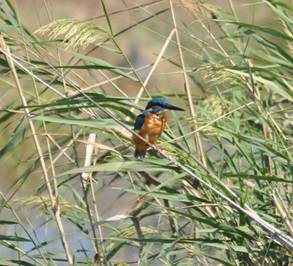 We were soon out of the airport and birding in earnest at Espais Naturals del Delta del Llobregat, which is situated right on the end of the runway. “A great place for plane spotters”. The local management team had busied themselves tidying the reserve by strimming many of the reed beds etc., possibly scaring the reserve’s inhabitants into North Africa. Although it’s true to say the reserve wasn’t exactly teeming with wildlife, some good birds were seen during our short stay. A Hobby busied itself catching flying insects above the reserve whilst a Kingfisher hovered and darted from one vantage point to another. Duck numbers were small, both in species and amount with Mallard the commonest. Teal, Shoveller, Pintail and Pochard were also recorded. A couple of Grey Heron stood sentinel over a dozen or so Lapwing loafing in the shallows, 3 Ruff dropped in and a single Snipe was seen feeding on one of the newly strimmed islands. On our return to the car park we were halted in our tracks by Stephen’s keen hearing; several Waxbill were located in the Tamarisk together with several Blackcap and some newly moulted Willow Warbler. Leaving the reserve we made a quick call at the local supermarket before arriving at the apartment to drop off the vittles and luggage, & have a quick swill before venturing forth to a local raptor spotting site Puig de Aliga where we spent a couple of hours watching migrating Honey Buzzard, Goshawk, Kestrel and Hobby. We returned to the apartment for an eagerly awaited pizza and some well-earned shut-eye, after all we had been up since 3.30 a.m.
We were soon out of the airport and birding in earnest at Espais Naturals del Delta del Llobregat, which is situated right on the end of the runway. “A great place for plane spotters”. The local management team had busied themselves tidying the reserve by strimming many of the reed beds etc., possibly scaring the reserve’s inhabitants into North Africa. Although it’s true to say the reserve wasn’t exactly teeming with wildlife, some good birds were seen during our short stay. A Hobby busied itself catching flying insects above the reserve whilst a Kingfisher hovered and darted from one vantage point to another. Duck numbers were small, both in species and amount with Mallard the commonest. Teal, Shoveller, Pintail and Pochard were also recorded. A couple of Grey Heron stood sentinel over a dozen or so Lapwing loafing in the shallows, 3 Ruff dropped in and a single Snipe was seen feeding on one of the newly strimmed islands. On our return to the car park we were halted in our tracks by Stephen’s keen hearing; several Waxbill were located in the Tamarisk together with several Blackcap and some newly moulted Willow Warbler. Leaving the reserve we made a quick call at the local supermarket before arriving at the apartment to drop off the vittles and luggage, & have a quick swill before venturing forth to a local raptor spotting site Puig de Aliga where we spent a couple of hours watching migrating Honey Buzzard, Goshawk, Kestrel and Hobby. We returned to the apartment for an eagerly awaited pizza and some well-earned shut-eye, after all we had been up since 3.30 a.m.
DAY 2 – Pyrenees

Up and on the road by 7.00 a.m. our aim today was to visit the Greixer Valley with the principle quarry being those special birds of the high tops, Lammergeier, Citril Finch, Alpine Chough etc. Our first stop was a small wooded valley that produced such delights as Rock Bunting, Short-toed Treecreeper, Crested Tit and Stonechat plus many commoner species that we are familiar with back home, Blackbirds, tits, thrushes, finches etc, etc, which for the sake of expediency will be referred to as “the usual suspects”.
Our second stop was at a much higher altitude where we had good views of the high peaks. Almost immediately we had distant views of Griffon Vulture circling above the peaks followed by at first 1 then 2 Lammergeier and a pair of Alpine Chough were noted near enough to spot their yellow bills, exaggerated by the strong morning light. A more distant flock of 20> Red-billed Chough was encountered wheeling in the thermals as only Chough can: 4 Raven were also spotted trying hard to mimic the Choughs’ aerobatics, but failing miserably. From here we climbed even higher so we were now above the tree line in what Stephen called Alpine meadow country.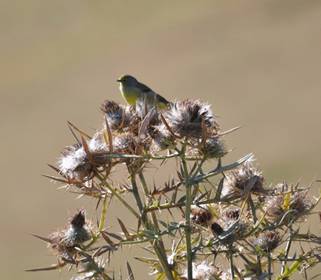 Several small flocks of Red-billed Chough were feeding on the short grass cropped by the small herd of bell-wearing cows. We were lucky enough to find a flock of Citril Finch feeding on thistle seeds near the roadside and we were treated to the antics of a male Sparrowhawk who appeared to be mock-attacking 3 Kestrel out of sheer devilment. Retracing our steps found us at a point where Stephen has had regular sightings of photographable Lammergeier. Luck was not on our side today although adequate compensation came in the guise of a low flying first year Golden Eagle with an adult in close attendance. As usually happens, I was stuffing my face with a sandwich, so I wasn’t quick enough with the camera. Our final stop of the day was a small park set alongside a mountain stream in the town of Baga. 3 steps from the car and we had already found at least 2 Dipper. A stroll through the park found Grey Wagtail, Firecrest and all the usual suspects.
Several small flocks of Red-billed Chough were feeding on the short grass cropped by the small herd of bell-wearing cows. We were lucky enough to find a flock of Citril Finch feeding on thistle seeds near the roadside and we were treated to the antics of a male Sparrowhawk who appeared to be mock-attacking 3 Kestrel out of sheer devilment. Retracing our steps found us at a point where Stephen has had regular sightings of photographable Lammergeier. Luck was not on our side today although adequate compensation came in the guise of a low flying first year Golden Eagle with an adult in close attendance. As usually happens, I was stuffing my face with a sandwich, so I wasn’t quick enough with the camera. Our final stop of the day was a small park set alongside a mountain stream in the town of Baga. 3 steps from the car and we had already found at least 2 Dipper. A stroll through the park found Grey Wagtail, Firecrest and all the usual suspects.
DAY 3 – Aiguamolls de L’emporda & Cap de Cruz
Today we were joined by a second couple, Roger and Liz from Kent and birded mainly the wetland reserves on the Cap de Cruz. This is what we refer to as English-style birding; bird hides strategically placed around areas of open water and reed-beds where you sit and wait to see what drops in. Our first stop produced Ruff, Wood Sandpiper, Snipe and Lapwing in the wader department. 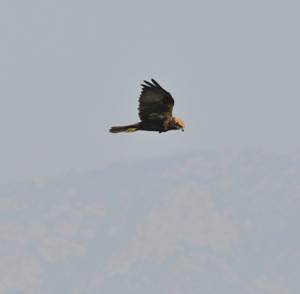 Grey Heron, Purple Heron, Cattle Egret and Greater Flamingo were dotted around the lagoon. Several common duck species were also noted. An immature male Marsh Harrier quartered the adjacent reed-beds giving excellent views. Crested Lark, Yellow Wagtail, Penduline Tit and Stonechat were the pick of the passerines.
Grey Heron, Purple Heron, Cattle Egret and Greater Flamingo were dotted around the lagoon. Several common duck species were also noted. An immature male Marsh Harrier quartered the adjacent reed-beds giving excellent views. Crested Lark, Yellow Wagtail, Penduline Tit and Stonechat were the pick of the passerines.
A small coastal hill populated with equally small Pines was our next stop and gave us the first real chance to stretch our legs since our 2 hour drive from our base. Good views of both Common and Black Redstart were had, together with a splendid Crested Tit and our only Tree Pipit of the trip. A fly-past Goshawk was an unexpected bonus. Lunch was taken in the hide on another part of the reserve, where we added Kingfisher and an obliging Water Rail which broke with all expected traditions by feeding out in the open amongst a small flock of Mallard. Our first Little Egret of the trip was noted together with several Fallow Deer which appeared to have swum or waded onto a small island. Long-tailed Tit was added to the passerine department. We said our goodbyes to Roger and Liz and embarked on the trip back by late afternoon.
DAY 4 – Ebro Delta

This was a part of the trip that intrigued us, as we had birded the Ebro Delta some years ago in March on our own, and as memory serves we saw very little, with the only bird to register in our minds being a feeding Little Tern – scant return for the very long journey to get there and its reputation as one of Europe’s premier wetlands. It was soon apparent that in the vastness that is the delta, we hadn’t been where the birds were. Not only was the place stuffed with many of the species associated with European wetlands, we didn’t recognise any of the places visited!
We left the apartment at 5.45 a.m. and collected Manfred Hoffman from his hotel in Sitges. Manfred was to bird with us for the rest of our trip. We arrived at the first site approximately 2hrs later. This site was a reed fringed lagooncontaining 2 bird hides, one of which was out of use because of dilapidation. On leaving the vehicle we walked down a track with flooded fields on both sides. The first thing that struck us was the amount of standing water on the track; there must have been some serious recent rain, something most of Spain hadn’t seen for some time. Tree Sparrow were the first birds to be identified, followed by several Reed Warbler criss-crossing the path in front of us, raising vain expectations of some photographs, which did not materialise. Many dozens of Purple Swamphen, some with very young chicks in tow, dashed across the path in an effort to reach the sanctity of a dense reed-bed to our right. Distant open water could be seen in this direction and a quick scan with the telescope produced both Cattle & Great Egret, Squacco & Grey Heron, Lapwing and Snipe. We retraced our steps back to the car-park and the adjacent hide. Things were relatively quiet in the hide apart from a very obliging Zitting Cisticola which perched on the reed fronds giving great views and an opportunity to get some good photos. Little Grebe, Kingfisher & Gadwall were added to the list.
 Our next port of call was a lagoon adjacent to the beach, running for several kilometres until our progress was stopped by a large desalination plant. A small sandbar held several Yellow-legged Gull and a single Slender-billed Gull. After several minutes they were joined by a Mediterranean Gull and an Audouin’s Gull was on a post nearby. There can’t be many places where you could see such a sight! We continued along the beach road, picking up Kentish & Ringed Plovers, Sanderling, Little Stint, Dunlin and Grey Plover. Several Sandwich Tern flew by with a purpose. Having our progress terminated by the gates to the aforementioned desalination plant, we retraced our steps to some open water adjacent to the road where we found many new species for the trip; Caspian Tern, Turnstone, Redshank, Spotted Redshank, Bar-tailed Godwit, Greenshank, Curlew and Purple Heron. Lunch was calling so we headed to a site that had a raised hide where we sat out of the sun eating our sandwiches. Several new species were also encountered, these included Red-crested Pochard, Shelduck, Night Heron, Whiskered Tern, Hoopoe and our one and only Little Tern for the trip.
Our next port of call was a lagoon adjacent to the beach, running for several kilometres until our progress was stopped by a large desalination plant. A small sandbar held several Yellow-legged Gull and a single Slender-billed Gull. After several minutes they were joined by a Mediterranean Gull and an Audouin’s Gull was on a post nearby. There can’t be many places where you could see such a sight! We continued along the beach road, picking up Kentish & Ringed Plovers, Sanderling, Little Stint, Dunlin and Grey Plover. Several Sandwich Tern flew by with a purpose. Having our progress terminated by the gates to the aforementioned desalination plant, we retraced our steps to some open water adjacent to the road where we found many new species for the trip; Caspian Tern, Turnstone, Redshank, Spotted Redshank, Bar-tailed Godwit, Greenshank, Curlew and Purple Heron. Lunch was calling so we headed to a site that had a raised hide where we sat out of the sun eating our sandwiches. Several new species were also encountered, these included Red-crested Pochard, Shelduck, Night Heron, Whiskered Tern, Hoopoe and our one and only Little Tern for the trip.
After our lunch break we embarked on driving around the vast rice fields for which this area is renowned. Many egrets and herons were seen, with one site holding at least 150 Glossy Ibis. These birds were already airborne on our arrival and as is usual, settled in the furthest corner of the rice field; once again making photography impossible. A small shrimp/fish farm was visited next; this was a location known by Stephen for holding wintering Squacco. Four Squacco were seen almost immediately diving for cover, Stephen was slightly dismayed that the small stew ponds were covered with new netting obviously used to deter predation of their contents, possibly forcing the Squacco Heron to abandon this reliable established site. More rice fields were visited before we eventually found ourselves running along the banks of the River Ebro. Many waders were seen; in the main they were the same as encountered elsewhere but in much greater densities. A Grey Plover, resplendent in full breeding plumage, stood out like a beacon; distinguishing Bar and Black-tailed Godwit by bill profile ensued and an Osprey was observed using the delta for refuelling during its migration. With these images still fresh in our memories we embarked on the long journey home.
DAY 5 – Spanish Steppe
Today was eagerly awaited, possibly more so than the others, as it gave us the opportunity to get reacquainted with birds we hadn’t seen for a few years. An early start this morning saw us deep in debate as we often were and only Jude’s sharp eye, and Stephen’s quick reflexes stopped us from sailing past Manfred who was stood patiently on the pavement outside his hotel. It wasn’t long before we had left the bustle of Sitges and were on one of the many new dual-carriageways that have erupted all over Spain. Some two and a half hours later we made our first site, a series of dirt tracks dissecting flat arid farmland. 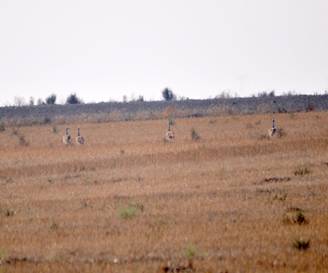 Several Stone Curlew, Northern Wheatear, Corn Bunting and Southern Grey Shrike were noted, along with a Thekla Lark which stayed long enough and showed well enough for Stephen to go through all the salient identification differences with a Crested Lark, something we had struggled with for many years. Finding a Crested for comparison proved a little more troublesome, but it was finally accomplished and the differences are not as subtle as the field guides suggest. Our first Little Owl were seen perched on the roofs of the semi-derelict buildings that dot the plains. A small flock of Calandra Lark was observed, showing their distinctive dark underwings and several Chough wheeled and called in flight. We had a distant view of 5 Black-bellied Sandgrouse , accompanied by a single Pin-tailed Sandgrouse. The unusual sight of half a dozen Red-legged Partridge catching the early morning warmth of the sun from the roof of a building is one that will stay long in the memory together with another encounter of low-flying Golden Eagle. A couple of distant but unmistakable Griffon Vulture were spotted in the “bins” whilst following the progress of the eagles. Retracing our steps back to the main road we parked on a service road adjacent to some small industrial units – Stephen’s keen eyesight had spotted 5 Great Bustard just a couple of hundred metres away. One bird flew off almost immediately with the other four making slow but steady progress away from us; again poor light and distance prevented the capturing of any decent photos.
Several Stone Curlew, Northern Wheatear, Corn Bunting and Southern Grey Shrike were noted, along with a Thekla Lark which stayed long enough and showed well enough for Stephen to go through all the salient identification differences with a Crested Lark, something we had struggled with for many years. Finding a Crested for comparison proved a little more troublesome, but it was finally accomplished and the differences are not as subtle as the field guides suggest. Our first Little Owl were seen perched on the roofs of the semi-derelict buildings that dot the plains. A small flock of Calandra Lark was observed, showing their distinctive dark underwings and several Chough wheeled and called in flight. We had a distant view of 5 Black-bellied Sandgrouse , accompanied by a single Pin-tailed Sandgrouse. The unusual sight of half a dozen Red-legged Partridge catching the early morning warmth of the sun from the roof of a building is one that will stay long in the memory together with another encounter of low-flying Golden Eagle. A couple of distant but unmistakable Griffon Vulture were spotted in the “bins” whilst following the progress of the eagles. Retracing our steps back to the main road we parked on a service road adjacent to some small industrial units – Stephen’s keen eyesight had spotted 5 Great Bustard just a couple of hundred metres away. One bird flew off almost immediately with the other four making slow but steady progress away from us; again poor light and distance prevented the capturing of any decent photos.
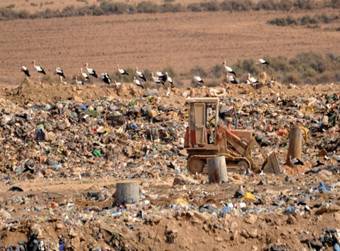 A quick snack and we were back plying some new track looking to have closer encounters with all of our quarry species. Closer views were obtained of both sandgrouse, but by this time our old enemy heat haze was playing a significant part in the clarity of views attained. No further Great Bustard were encountered. Little Bustard, another target species, were not seen during the trip; apparently they were in full moult so were incredibly difficult to locate. A stop-off at a rubbish dump did turn up the only Red Kite of the trip together with the spectacle of several hundred White Stork picking at the scraps on offer: not the usual sighting of storks elegantly picking their way through verdant water meadows. With time pressing and the late afternoon heat becoming a little uncomfortable we embarked on our long journey back.
A quick snack and we were back plying some new track looking to have closer encounters with all of our quarry species. Closer views were obtained of both sandgrouse, but by this time our old enemy heat haze was playing a significant part in the clarity of views attained. No further Great Bustard were encountered. Little Bustard, another target species, were not seen during the trip; apparently they were in full moult so were incredibly difficult to locate. A stop-off at a rubbish dump did turn up the only Red Kite of the trip together with the spectacle of several hundred White Stork picking at the scraps on offer: not the usual sighting of storks elegantly picking their way through verdant water meadows. With time pressing and the late afternoon heat becoming a little uncomfortable we embarked on our long journey back.
DAY 6 – Pyrenees
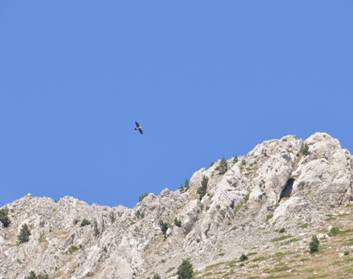 Today we returned to the Pyrenees, albeit a different location to the one visited on Day 2. Stephen wanted to try another valley where he had regularly had Lammergeierat photographable height on several occasions; he has also had them breaking bones on the scree slopes opposite. So confident was Stephen that he said the bird would put in an appearance between 12.30 & 13.00hrs. Sure enough, a bird appeared with a couple of minutes to spare, not as close as we would have wanted for photographic purposes, but giving great views through both bins & scope. Migration was clearly in evidence with a procession of approximately 20> Ring Ouzel dropping in to a small stand of pines in the valley below, their pale wing markings showing up well against the shadows cast in the valley. Further along the valley eagle-eyed Stephen stopped the car adjacent to the top of a Pine growing out of the slope below us; a male Crossbill sat on the very tip, appearing to be catching the sun’s rays which were beginning to reach our half of the valley. Again circumstances conspired against us, with the sun being behind the bird giving only silhouetted snaps… “bugger!”
Today we returned to the Pyrenees, albeit a different location to the one visited on Day 2. Stephen wanted to try another valley where he had regularly had Lammergeierat photographable height on several occasions; he has also had them breaking bones on the scree slopes opposite. So confident was Stephen that he said the bird would put in an appearance between 12.30 & 13.00hrs. Sure enough, a bird appeared with a couple of minutes to spare, not as close as we would have wanted for photographic purposes, but giving great views through both bins & scope. Migration was clearly in evidence with a procession of approximately 20> Ring Ouzel dropping in to a small stand of pines in the valley below, their pale wing markings showing up well against the shadows cast in the valley. Further along the valley eagle-eyed Stephen stopped the car adjacent to the top of a Pine growing out of the slope below us; a male Crossbill sat on the very tip, appearing to be catching the sun’s rays which were beginning to reach our half of the valley. Again circumstances conspired against us, with the sun being behind the bird giving only silhouetted snaps… “bugger!”
Most of the birds encountered during our previous visit were seen; several large mixed flocks of Chough were also seen but again they had the knack of remaining beyond the limits of my lenses… “bugger, bugger!” A stop to look for Dipper below the town of Baga produced two Mink, both intent in hunting, with one passing directly below the redundant road bridge we were stood on. Stephen wasn’t previously aware of Mink in the region.
DAY 7 – Garraf & Llobregat
 This was our last day and with our flight scheduled for 16.40hrs we had time for some local birding. We were up and packed and picking Manfred up by 8.30 a.m. The plan was to bird the Garraf National Park in the morning then move on to the Llobregat Delta which is situated at the end of Barcelona’s runway. The first part of the day was completed with a visit to the coastal part of the Garraf, then moving inland looking for any late migrants that might be feeding up on the fruiting shrubs which abound in this part of the reserve. Although no new birds were seen, our interest was maintained with many small passerines flitting from bush to bush. One small field contained a loose flock of no less than 15 Blackcap, something you don’t see every day. Zitting Cisticola, Common Redstart, Sardinian Warbler, Northern Wheatear, Stonechat and Serin were all seen in good numbers as well as the usual suspects. We arrived at Llobregat at around lunch time. Our plan was to bird until 2hrs before our flight.
This was our last day and with our flight scheduled for 16.40hrs we had time for some local birding. We were up and packed and picking Manfred up by 8.30 a.m. The plan was to bird the Garraf National Park in the morning then move on to the Llobregat Delta which is situated at the end of Barcelona’s runway. The first part of the day was completed with a visit to the coastal part of the Garraf, then moving inland looking for any late migrants that might be feeding up on the fruiting shrubs which abound in this part of the reserve. Although no new birds were seen, our interest was maintained with many small passerines flitting from bush to bush. One small field contained a loose flock of no less than 15 Blackcap, something you don’t see every day. Zitting Cisticola, Common Redstart, Sardinian Warbler, Northern Wheatear, Stonechat and Serin were all seen in good numbers as well as the usual suspects. We arrived at Llobregat at around lunch time. Our plan was to bird until 2hrs before our flight.
Lunch was to be taken in the relative cool and shade of one of the hides. It came as a bit of a shock to find the reserve closed with its large entry gates firmly padlocked shut. A chance meeting with one of the reserve wardens later in the day confirmed that due to a lack of funding the reserve would now close on Mondays. We returned to the car-park, which also had some picnic benches, and proceeded to have lunch with commercial jets less than 50mtrs above our heads; the noise was ear shattering! Stephen made a few phone calls and came up with an alternative. He knew of a raptor watch-point just outside Barcelona where they had been having good numbers of raptors passing through. Never ones to give up an opportunity to improve our raptor identification skills, we consulted with Manfred and agreed. The observation point was on a hill with panoramic views of Barcelona below; the next hour & half was spent under a large sunshade and in the company of the Spanish Raptor Group rep. A look at previous daily logs confirmed that large numbers of raptors had been passing through and a look at the current sheet showed that only six birds had passed so far that day. During the time we spent there we had distant views of a Hobby, Kestrel and 2 Buzzard – true, not a great return but infinitely better than spending the time in a crowded airport terminal.
SUMMARY
Our trip list consisted of 146 species seen, whilst several others were seen by Stephen either fleetingly, so we didn’t get on them, or not seen sufficiently well enough for us to confirm the sighting. Several others were only heard and these we don’t count, after all we are bird watching, not bird listening!
Catalan Bird Tours
We only have praise for the professional attitude we encountered whilst dealing with the company. Emails were always answered promptly and all the information we required was given unambiguously. If we had to be hyper-critical we found the web site a little cluttered and it took us a couple of visits to extract the information we required. We are aware that Catalan offer bespoke trips the year round and to suit most people’s requirements it needs to contain lots of information.
As a guide Stephen was excellent, both in his identification skills and fieldcraft. His hearing was better than any guide we have ever used; he could detect Firecrest calling whilst driving along gravel tracks. We found it difficult to hear them once we left the vehicle! Stephen was very patient and did his level best to make sure we got the best possible sighting and was happy to point out subtle plumage changes between races of the same species. We would be happy to highly recommend Catalan Bird Tours to anybody wanting to bird this part of Spain.
Accommodation
We opted for the studio apartment situated on the ground floor of Stephen’s house. The apartment was accessed either through a games room containing a table tennis table & pool table or through a side door which led directly into the apartment. It contained 2 bedrooms, both with a double bed and small chest of drawers. The living/dining area was one room which contained a kitchen area with a fridge/freezer, gas hob & electric oven, electric kettle, toaster, coffee percolator, lots of cupboards and drawers containing all the utensils and pots & pans required for self-catering. A put-you-up and dining table with 4 chairs provided the seating. A washing machine was in one corner – we didn’t use it but we assumed it was plumbed in and ready to use should we have required it. The apartment was clean and fit for the purpose intended. For the sake of fairness we have to say that having a toilet and bathroom detached from the main living area was not ideal, especially if you require the toilet during the hours of darkness. Two outside lights with motion sensors illuminated the way to the toilet some dozen metres away, a brolly would be required should the weather turn inclement.
Most of our evenings were spent on a couch in the games room, which for us was the most comfortable; the large open plan windows afforded good views of the many bats that hawked around the garden during the hours of twilight.
MOANS, GROANS & MEMORABLE MOMENTS
Moan
British Airways “Britain’s Favourite Airline” – our flight was delayed both ways: combined delay for both flights was almost 5hrs – “not good enough British Airways”
Groan
Not obtaining the photos hoped for. This is not the fault of Catalan Tours, if the truth be told the type of photos I was hoping for would need many trips and a fair amount of luck, but a tadge disappointed all the same.
Moan
Nightly visits to the loo!!!
Memorable moments
The low fly-bys of the Golden Eagles, especially in the Pyrenees.
The dog-fights between a male Sparrowhawk and 3 Kestrels; it appeared the birds were having great fun playing an avian form of tag. In truth it was probably a little more serious than that.
The close encounters with Citril Finches feeding on thistle heads at the side of the road.
The large flock of Glossy Ibis that filled the sky before landing out of camera range in a distant corner of a large rice field.
Birding for a day with Liz & Roger and especially the time spent birding with Manfred.
Actually birding the Ebro delta, a place we thought we had birded some years previously, but obviously we hadn’t.
The whole experience of birding in the company of our guide Stephen Christopher.
